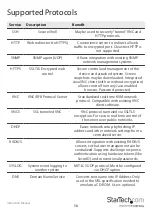
Instruction Manual
45
Connecting a Modem
The SV1115IPEXT will work with virtually any Hayes-compatible modem that
recognizes the standard AT command set. Some modem manufacturers offer
“enterprise” grade modem products (at a premium price) that include technology to
improve the stability of connections; whether this type of product would be beneficial
to your application depends on whether you consider the modem connection to
be mission-critical, the quality of your telecom infrastructure, and your budget for
implementing this solution. The model of modem attached is essentially transparent to
the SV1115IPEXT.
It is important to note that modems that offer “56K” (or 56,000 bps) connections
often achieve connection speeds that are far lower than their maximum capabilities.
Given the limitations of telecom infrastructure (many locations have yet to implement
fully digital switching technology, and still rely on older analog technology for some
segments), the maximum “upstream” transfer rate is limited to a maximum of 33,600
bps between two modems; the “downstream” rate is often within a similar range for a
typical connection. Therefore, speeds below 56,000 bps do not indicate a problem with
the modem or the SV1115IPEXT, but simply reflect the line conditions at the time the
connection is made.
The DTE Serial port on the front panel can be used for serial port configuration when
the modem is connected. It requires the use of a null modem serial cable.
The DCE Serial port on the rear panel is used to connect the modem to the
SV1115IPEXT and requires the use of a straight through serial cable.
Place the modem near the SV1115IPEXT and an available telephone jack. Connect
the modem to the telephone jack, data cable, and power source according to the
instructions in its documentation. The opposite end of the modem’s data cable should
be a DB9 female serial connection. Connect that end of the cable to the DCE Serial
connection on the rear panel of the SV1115IPEXT
















































